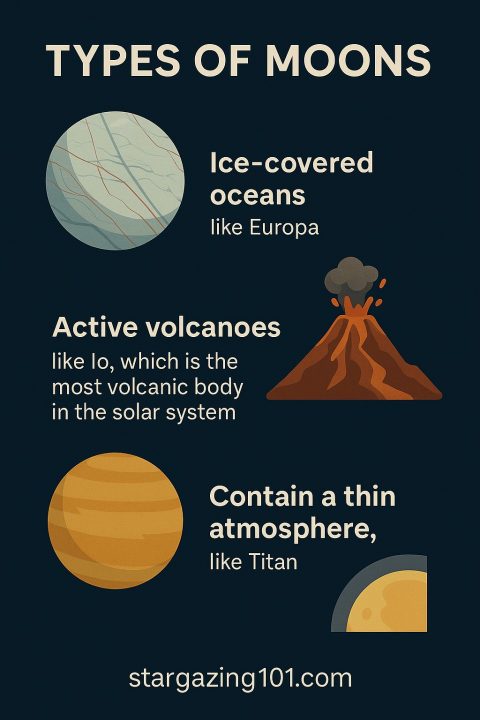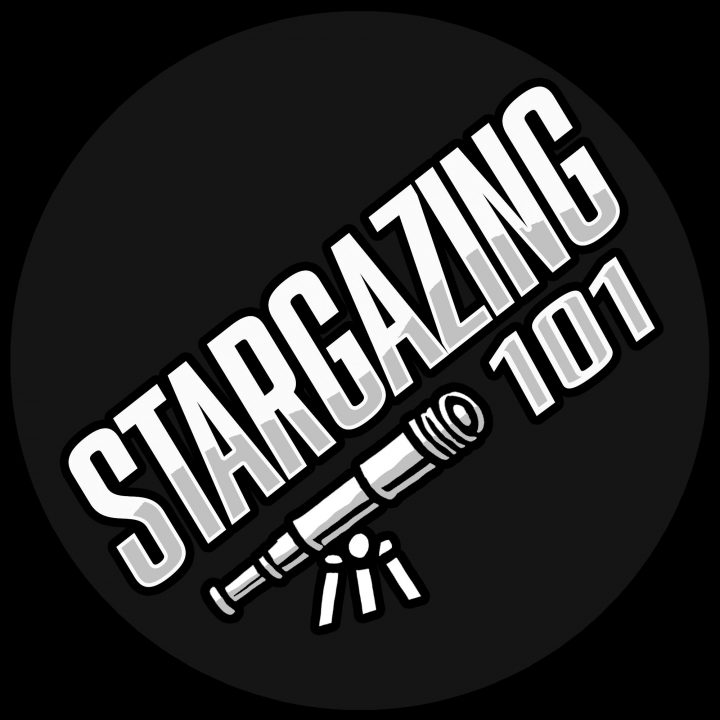Moons of the Solar System: A Beginner’s Guide
The moon is often the first, and only thing many people focus on (non enthusiast).
If you are planning on spending some time viewing the moon, then a guide like this one is a MUST-have Available on: Amazon UK | Amazon US
A moon map shows you things such as:
- A large number of Moon features, with a clear index
- Craters, seas, mountains, peaks and valleys
- Landing sites of manned and unmanned spacecraft located
In a hurry? Find your way around fast:
What Exactly Are Moons?
A moon is a natural satellite that orbits a planet, dwarf planet, or asteroid. Some are as big as planets themselves (like Ganymede, which is around twice the size of Mercury!), while others are just a few miles across.
Are All Moons The Same?
Put simply, moons are celestial bodies that orbit other celestial bodies.
However, they can vary greatly, and can be:
- Ice-covered oceans, like Europa.
- Active volcanoes, like Io, which is the most volcanic body in the solar system.
- Contain a thin atmosphere like Titan.
- Or, they can be little lumpy rocks tumbling through space.
How Many Moons Are in The Solar System?
There are around 900 natural moons in our solar system and almost a third of which are orbiting Saturn.
Here’s a quick look at the current moon count by planet:
Earth – 1 Moon
Earth of course only has a single moon, The Moon. But if we take into account artificial satellites, like those we use for GPS, internet, and surveillance, there are close to 12,000 satellites orbiting the planet Earth.
The Moon was the first celestial body outside of Earth that we stepped foot on, during the Apollo missions.
And to date, humans have only stepped foot on a single celestial body beyond Earth.
Want to Learn More About the Apollo Moon Landings and How Many Flags Are Left on the Moon?
Check out our post: Can You See the Apollo 11 Flag on the Moon with a Telescope?
What is The Name of Earth’s Moon?
Though The Moon is often referred to as Luna, it’s official name is simple The Moon.
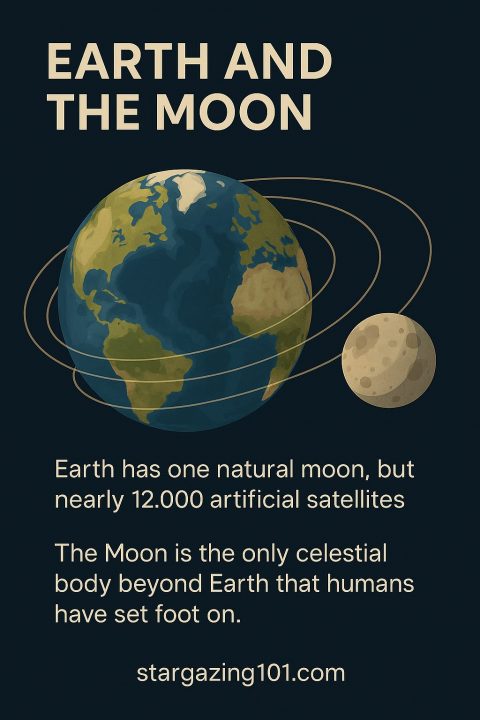
Mars – 2 Moons
What are the names of all of Mars’s moons?
Mars’s moons are named Phobos and Deimos.
Jupiter – 95 Moons
Jupiter has 95 moons, officially confirmed or named by the International Astronomical Union (IAU). The most famous of these Jupiter satellites are the four discovered and logged by the famous astronomer Galileo Galilei in 1610.
Jupiter’s Galilean satellites are named Io, Europa, Ganymede, and Callisto, and were the first moons ever observed orbiting another planet.
What Are Jovian Moons?
Jovian moons are the natural satellites (moons) that orbit the Jovian planets—a term used to describe the gas giants in our solar system. These planets are:
- Jupiter
- Saturn
- Uranus
- Neptune
The word “Jovian” comes from “Jove,” another name for the Roman god Jupiter. So “Jovian” literally means “of or relating to Jupiter.” Over time, astronomers began applying the term “Jovian planets” to refer to all gas giants, not just Jupiter, because of their similar physical characteristics (large, gaseous, ring systems, many moons).
Therefore, “Jovian moons” are technically:
- The moons of Jupiter (most accurately).
- But more broadly, any moons that orbit the gas giants in our solar system.
What Are Galilean Moons?
The Galilean moons are the four largest moons of Jupiter, discovered in 1610 by Galileo Galilei using one of the earliest telescopes. They were the first moons ever found orbiting another planet, and their discovery was a major moment in astronomy because it challenged the idea that everything revolved around the Earth.
The Four Galilean Moons (in order of distance from Jupiter):
Least geologically active of the four.
Io
The most volcanically active body in the solar system.
Surface covered with sulphur and lava flows.
Has over 400 active volcanoes.
Europa
Icy surface with a subsurface ocean beneath.
Strong candidate for potential extraterrestrial life.
Surface is smooth and bright, with cracks instead of craters.
Ganymede
The largest moon in the solar system (even bigger than Mercury).
Has a magnetic field.
Believed to have a subsurface ocean.
Callisto
Heavily cratered and ancient surface.
Possibly has a subsurface ocean.
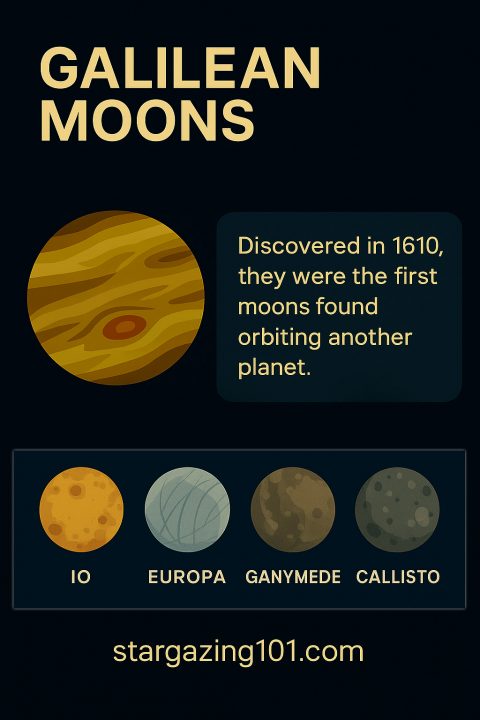
Why Are They Called “Galilean” Moons?
They’re named after Galileo, who discovered them. Their names (Io, Europa, Ganymede, Callisto) come from mythological lovers of Zeus (the Greek equivalent of Jupiter).
Does Jupiter Have 79 or 80 Moons?
Jupiter actually has more than 90 moons, 95 as of the last count. The reason people may think there are less is due to the fact that moons are discovered everyday, for example, more than 100 new moons were discovered recently for Saturn alone.
Need help finding the perfect telescope to get started with moon astronomy?
Free PDF: Choosing Your First (or Next) Telescope
Choosing your first telescope doesn’t have to be overwhelming.
Inside this free guide, you’ll discover how to:
- Buy with confidence by understanding which telescope fits your goals
- Save time, money, and stress by avoiding beginner mistakes
- See craters, moons, and nebulae clearly with the right eyepieces
- Choose a scope that fits your life—not just your budget
- Shop smarter using a printable checklist you can take with you
Tell us where to send it, and we’ll email you the full PDF now:
Saturn – 274 Moons
Saturn has 274 moons, with the biggest being Titan, a moon which is actually larger in diameter than Mercury.
What are the names of Saturn’s moons?
Saturn’s 274 moons are named Titan, Rhea, Iapetus, Dione, Tethys, Enceladus, Mimas, Hyperion, Phoebe, Pan, Daphnis, Atlas, Prometheus, Pandora, Epimetheus, Janus, Aegaeon, Methone, Anthe, Pallene, Helene, Polydeuces, Telesto, Calypso, Tarqeq, Kiviuq, Ijiraq, Paaliaq, Tarvos, Ymir, Suttungr, Thrymr, Mundilfari, Skathi, Erriapus, Albiorix, Siarnaq, Bebhionn, Bergelmir, Bestla, Farbauti, Fenrir, Fornjot, Hati, Hyrrokkin, Kari, Loge, Skoll, Surtur, Jarnsaxa, Greip, Narvi, Aegir, Gridr, Angrboda, Skrymir, Gerd, S/2004 S26, Eggther, S/2004 S29, Beli, Gunnlod, Thiazzi, S/2004 S34, Alvaldi, Geirrod, S/2004 S7, S/2004 S12, S/2004 S13, S/2004 S17, S/2004 S21, S/2004 S24, S/2004 S28, S/2004 S31, S/2004 S36, S/2004 S37, S/2004 S39, S/2004 S40, S/2004 S41, S/2004 S42, S/2004 S43, S/2004 S44, S/2004 S45, S/2004 S46, S/2004 S47, S/2004 S48, S/2004 S49, S/2004 S50, S/2004 S51, S/2004 S52, S/2004 S53, S/2004 S54, S/2004 S55, S/2004 S56, S/2004 S57, S/2004 S58, S/2004 S59, S/2004 S60, S/2004 S61, S/2005 S4, S/2005 S5, S/2005 S6, S/2005 S7, S/2006 S1, S/2006 S3, S/2006 S9, S/2006 S10, S/2006 S11, S/2006 S12, S/2006 S13, S/2006 S14, S/2006 S15, S/2006 S16, S/2006 S17, S/2006 S18, S/2006 S19, S/2006 S20, S/2006 S21, S/2006 S22, S/2006 S23, S/2006 S24, S/2006 S25, S/2006 S26, S/2006 S27, S/2006 S28, S/2006 S29, S/2007 S2, S/2007 S3, S/2007 S5, S/2007 S6, S/2007 S7, S/2007 S8, S/2007 S9, S/2007 S10, S/2007 S11, S/2009 S1, S/2019 S1, S/2019 S2, S/2019 S3, S/2019 S4, S/2019 S5, S/2019 S6, S/2019 S7, S/2019 S8, S/2019 S9, S/2019 S10, S/2019 S11, S/2019 S12, S/2019 S13, S/2019 S14, S/2019 S15, S/2019 S16, S/2019 S17, S/2019 S18, S/2019 S19, S/2019 S20, S/2019 S21, S/2019 S22, S/2019 S23, S/2019 S24, S/2019 S25, S/2019 S26, S/2019 S27, S/2019 S28, S/2019 S29, S/2019 S30, S/2019 S31, S/2019 S32, S/2019 S33, S/2019 S34, S/2019 S35, S/2019 S36, S/2019 S37, S/2019 S38, S/2019 S39, S/2019 S40, S/2019 S41, S/2019 S42, S/2019 S43, S/2019 S44, S/2020 S1, S/2020 S2, S/2020 S3, S/2020 S4, S/2020 S5, S/2020 S6, S/2020 S7, S/2020 S8, S/2020 S9, S/2020 S10, S/2020 S11, S/2020 S12, S/2020 S13, S/2020 S14, S/2020 S15, S/2020 S16, S/2020 S17, S/2020 S18, S/2020 S19, S/2020 S20, S/2020 S21, S/2020 S22, S/2020 S23, S/2020 S24, S/2020 S25, S/2020 S26, S/2020 S27, S/2020 S28, S/2020 S29, S/2020 S30, S/2020 S31, S/2020 S32, S/2020 S33, S/2020 S34, S/2020 S35, S/2020 S36, S/2020 S37, S/2020 S38, S/2020 S39, S/2020 S40, S/2020 S41, S/2020 S42, S/2020 S43, S/2020 S44, S/2023 S1, S/2023 S2, S/2023 S3, S/2023 S4, S/2023 S5, S/2023 S6, S/2023 S7, S/2023 S8, S/2023 S9, S/2023 S10, S/2023 S11, S/2023 S12, S/2023 S13, S/2023 S14, S/2023 S15, S/2023 S16, S/2023 S17, S/2023 S18, S/2023 S19, S/2023 S20, S/2023 S21, S/2023 S22, S/2023 S23, S/2023 S24, S/2023 S25, S/2023 S26, S/2023 S27, S/2023 S28, S/2023 S29, S/2023 S30, S/2023 S31, S/2023 S32, S/2023 S33, S/2023 S34, S/2023 S35, S/2023 S36, S/2023 S37, S/2023 S38, S/2023 S39, S/2023 S40, S/2023 S41, S/2023 S42, S/2023 S43, S/2023 S44, S/2023 S45, S/2023 S46, S/2023 S47, S/2023 S48, S/2023 S49, S/2023 S50
Uranus – 27 Moons
Uranus is so big, it managed to trap 27 moons. And all 27 moons are officially recognized by the IAU.
What makes its moons stand out is that most of them are named after characters from the works of Shakespeare and Alexander Pope, rather than mythological gods.
The largest moons of Uranus are Titania, Oberon, Umbriel, Ariel, and Miranda. Titania is the biggest, while Miranda is known for having one of the most chaotic and unusual surfaces in the solar system.
How Do You Correctly Pronounce Uranus?
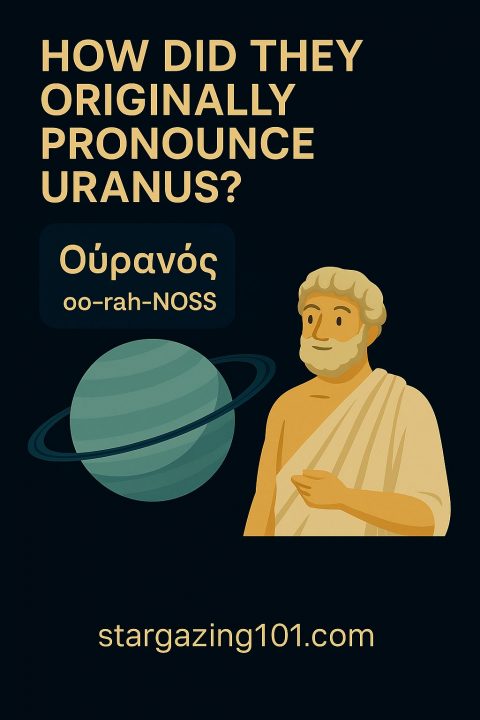
The original Greek name is Οὐρανός, which is pronounced “oo-rah-NOSS”. The mythological name translates to “sky” or “heaven.” So if you really want to sound like you know your stuff, drop a casual “Ouranos” into conversation.
There are a couple of accepted ways to say it in modern English. The most common is “YOOR-uh-nus”, which is what you’ll hear from most astronomers and science presenters trying to keep a straight face. There’s also “YURR-uh-nus”, which many folks prefer just to avoid the whole… well, you know.
Whichever way you say it, you’re not wrong. But now you’ve got options.
Just maybe don’t yell “Your Anus” in a planetarium.
Neptune – 16 Moons
Neptune, AKA the blue giant, has 16 moons. The biggest of which is called Triton.
What are the names of all of Neptune’s moons?
Neptune’s moons are named Triton, Nereid, Naiad, Thalassa, Despina, Galatea, Larissa, Proteus, Halimede, Psamathe, Sao, Laomedeia, Neso, Hippocamp, S/2002 N5, S/2021 N1.
Pluto – 5 Moons
Pluto has five moons, its largest, Charon, is around half the size of Pluto itself!
What are the names of all of Neptune’s moons?
Pluto’s moons are named Charon, Nix, Hydra, Kerberos, and Styx.
Can a Dwarf Planet Have Moons?
I’m pretty sure it was the Braveheart movie, in which Mel Gibson said: “They may take out planetary status, but they’ll never take our moon.” or something to that extent…
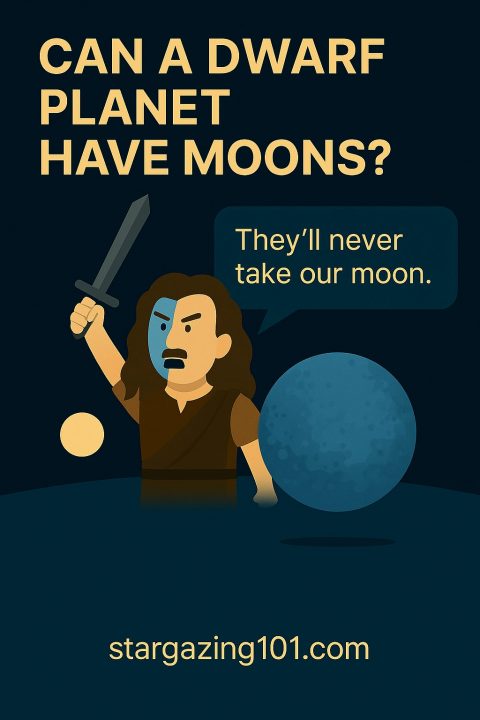
Afterall, you can’t say dwarf planet, without saying planet, right?
Pluto may not be considered a planet anymore, but luckily, you don’t have to be a planet to have a moon. Most of the moons we hear about orbit planets, so it’s easy to assume that’s a requirement, but it’s not.
Moons also orbit dwarf planets and even some asteroids.
Two other dwarf planets, Haumea and Eris also have moons, Haumea has two which are named Hiʻiaka and Namaka, and Eris, like the Earth, only has one, named Dysnomia.
Who Decided Pluto Wasn’t a Planet?
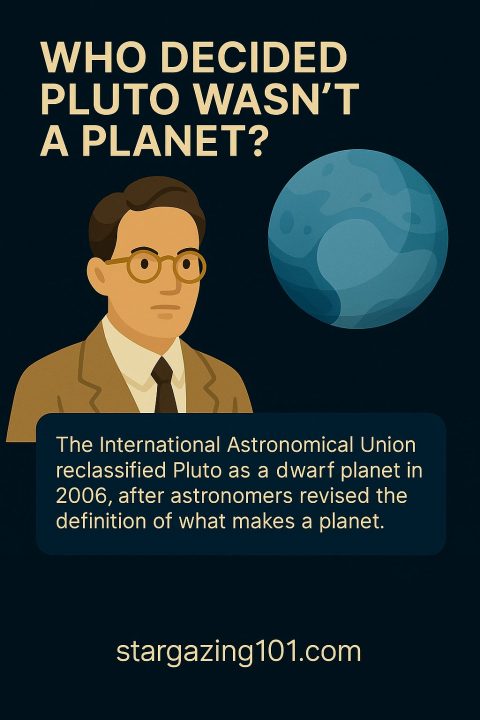
In 2006, the International Astronomical Union (IAU) officially reclassified Pluto as a dwarf planet, and just like that, the solar system went from nine planets to eight.
So… who gave them the right?
Well, the IAU is basically the big boss of space naming. They’re the ones who standardize things like what counts as a planet, how moons are named, and whether a newly discovered object should be called “Planet X” or something more official. And during their 2006 meeting, they introduced a new definition of what makes a planet a planet.
According to the new rules, a planet must:
- Orbit the Sun
- Be big enough for gravity to make it round
- Clear its orbital zone of other debris ← Pluto fails this one
That third point was the kicker. Pluto shares its neighbourhood with loads of other icy bodies in the Kuiper Belt, which means it didn’t make the cut under the new definition.
But don’t worry. Pluto still has five moons, an atmosphere, heart-shaped plains, and a cult following. Planet or not, it’s not going anywhere.
Mercury – 0 Moons
Mercury is the closest planet to the Sun, and it doesn’t have a single moon to its name. Why? Its proximity to the Sun makes it nearly impossible for Mercury to hold onto a moon, the Sun’s gravity would just snatch it away.
So if you’re looking for moons, you’ll have to look a little further out.
Venus – 0 Moons
Venus doesn’t have any moons either, which might seem wrong for the planet often called Earth’s twin. But being the second planet from the Sun, Venus is stuck in a gravitational tug-of-war that makes it hard to hold onto a satellite. So if you’re hoping to spot a Venusian moon through your telescope, you’ll be waiting a long time.
When Is a Moon Officially Counted?
Not every object spotted orbiting a planet is immediately recognized as an official moon. To be officially counted, a moon must go through a confirmation process overseen by the International Astronomical Union (IAU). Here’s how it works:
Here’s how the process works:
- Initial Discovery – Astronomers detect a new object that appears to be orbiting a planet.
- Ongoing Observations – The object’s orbit must be tracked over time to confirm it is a natural satellite and not a passing asteroid or temporary capture.
- Orbital Confirmation – Once the orbit is verified and proven stable, the object is considered a confirmed moon.
- IAU Recognition – The IAU assigns a provisional designation (e.g., S/2025 S1 for Saturn), and in some cases, an official name is given later.
Though there are more moons than we currently count against each planet, they don’t count until they have undergone this process.
When is a moon not a moon? What doesn’t count yet?
- Objects observed only once or without a confirmed orbit.
- Candidate moons that are still being tracked and studied.
- Early announcements made by scientists or media before IAU approval.
In short, a moon is only added to a planet’s official count once the IAU confirms it. While new discoveries are exciting, they aren’t included in the totals until they pass this rigorous process.
Can You See Any Moons Through a Telescope?
Absolutely. And you don’t need a massive observatory on a remote mountain to do it. A basic backyard telescope or even a good pair of binoculars can show you some of the best moons in the solar system.
Let’s start with Jupiter. The big one. If you aim a telescope at it, you’ll probably see a few tiny dots hanging out beside the planet. Those are Io, Europa, Ganymede, and Callisto. Galileo spotted them back in the 1600s, and you can too. They move quickly, so if you look again later that night, they’ll have changed position. It’s like watching a miniature solar system doing its thing in real time.
Now onto Saturn. The ringed favorite. Its largest moon, Titan, is visible through smaller scopes as a faint but steady dot nearby. If your skies are dark enough and your telescope is cooperating, you might even spot a few more of Saturn’s moons. They’re fainter and harder to catch, but they’re out there.
And of course, our own Moon. You don’t need fancy gear to be impressed by it, but through a telescope, it turns into an entirely different world. You’ll see craters, ridges, and shadowy plains in sharp detail. If you use a lunar filter, even better. It helps tone down the brightness so you can soak in more contrast.
How To See Moons Through A Telescope
- Start with low magnification and zoom in once you find your target.
- Try not to observe the Moon when it’s full, since the lighting is flat and detail gets washed out.
- Jupiter and Saturn are easiest to see when they’re higher in the sky, away from the glow of the horizon.
Top Tip:
The Moon is also surprisingly bright through a telescope, and it gets brighter the more you magnify, If you plan to look at it, opt for a moon filter.
My favourite Moon filter this one from Celestron Available on: Amazon UK | Amazon US it’s variable, which means that you can control the amount of light allowed though the eyepiece by rotating the polarized lens.
I’m not a fan of coloured filters, but this Moon filter is an acceptation, it’s a truly must-have piece of kit if you value your night vision and viewing enjoyment.
Quick Fact: The biggest moon in the solar system is Ganymede, even larger than Mercury. The smallest confirmed moons are often just a few kilometers wide, like some of Saturn’s newly discovered tiny satellites.
How Many Moons Have We Landed On?
We’ve landed craft on two moons in our solar system. The first is our own moon, which we have landed on more than 30 times, and the second is Saturn’s moon Titan, where we’ve only landed once.
The Huygens probe became the first and only spacecraft to land on Titan, an even which took place more than 20 years ago in 2005.
Enjoyed this post? If you’d like to support the creation of more beginner-friendly guides and tools, you can buy me a coffee. It means a lot. ☕
Related Pages to Explore
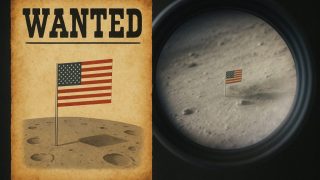
Check out our post: Can You See the Apollo 11 Flag on the Moon with a Telescope?
Tip #11
"Jupiter’s four largest moons can be seen with binoculars and change position nightly."
-Tip #11


